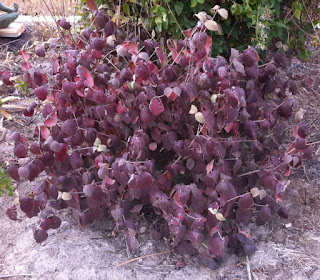 I've tried several off and on, and I continually keep picking up Brenner and Scanniello's A Rose By Any Name and knocking off a few pages, but my main theme this season seems to be "back-to-the-farm" literature. I keep picking up and putting down Margaret Roach's And I Shall Have Some Peace There, but I'm having trouble identifying with Margaret's "successful-woman-middle-aged-angst" crisis. No surprise there, since a puttering older male is probably not her target audience.
I've tried several off and on, and I continually keep picking up Brenner and Scanniello's A Rose By Any Name and knocking off a few pages, but my main theme this season seems to be "back-to-the-farm" literature. I keep picking up and putting down Margaret Roach's And I Shall Have Some Peace There, but I'm having trouble identifying with Margaret's "successful-woman-middle-aged-angst" crisis. No surprise there, since a puttering older male is probably not her target audience.I recently finished, however, and enjoyed immensely The Dirty Life by Kristin Kimball. Subtitled "a memoir of farming, food, and love," it chronicles her move from NYC to northern New York with her soon-to-be-husband, an arduous back-to-the-basics to establish a community farm in the North Country. The book is not so much about the love, since she notes that on most nights they managed only exhaustion and worry, but it's a lot about the farming and food and the localism movement trumpeted these days by the ecological aristocracy. All in all, The Dirty Life is an easy and likable read. Kimball, by the way, is no shrinking hippified housewife, as the jacket blurb notes that she has a degree from Harvard, and the last I knew, Harvard was not known for its agricultural program.
For me, Kimball's tales of farming with draft horses, primitive balers, maple syrup production, unrepentant swine, nervous chickens, and endless daily work prompted fond recall of times I spent in Amish country. Thirty years ago, I spent two months on externship as a 4th year veterinary student at a large dairy practice in Wakarusa, Indiana. Wakarusa, with a population of 1758 in the 2010 census, was even smaller in 1982, a place back then whose local Pizza Hut, the only "eat-out" restaurant for 15 miles, became a hot spot every Friday night for young Mennonite boys and bonneted teenage girls. Wakarusa was in Elkhart County, one of two northern Indiana counties where the population was predominantly Amish and Mennonite and the veterinary practice I worked in served the small family farms and dairies of the area. For two months, I lived on and off of those farms, in Amish barns and fields, knee deep at times in dairy muck and at other times holding for dear life to the lead ropes of Draft horses whose backs were taller than my heads. Two months among good people who lived plainly, by the strength of their arms and the sweat of their brows. A part of me still longs to be there.
.jpg)







.jpg)